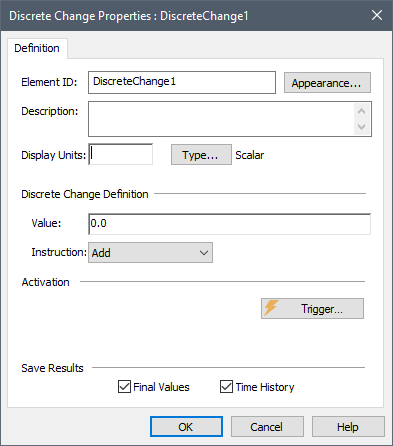
The Discrete Change element is triggered by an event, and responds by emitting a discrete change signal. The triggering event can be a discrete event signal or another type of event (e.g., a condition, such as X becoming greater than Y).
For financial models, Discrete Changes are used to represent discrete financial transactions (e.g., deposits, withdrawals, purchases, sales).
The dialog for a Discrete Change element looks like this:

You first specify when the element is to be triggered via the Trigger… button in the Discrete Change dialog. The Trigger… button provides access to a standard Trigger dialog.
Once the element is triggered, it emits a discrete change signal. A discrete change signal contains information regarding the response to an event and consisting of two pieces of information: a Value (e.g., 10 dollars) and an Instruction (e.g., Add).
For financial models, the Value always has dimensions of currency, and can be a number (e.g., 10 $) or a link. The required order (scalar, vector or matrix) of the Value is specified in a dialog accessed via the Type… button. Financial Module elements generally only accept scalar discrete change signals (with the exception of Investment elements, which also accept vectors).
The Instruction drop-list contains two choices: "Add" and "Replace". This instructs the element(s) receiving the discrete change signal how to act upon the value being received.
Learn more about: